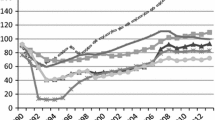Abstract
This chapter examines the relationships between foreign direct investment (FDI) flows into Ukraine, and imports and exports to and from the country. Theoretically, FDI and international trade can be substitutes or complements. Empirically, the paper shows that FDI from the European Union (EU) into primary industries is mostly export-oriented and thus complements trade, whereas that into secondary, manufacturing industries tends to substitute for trade. The paper argues that primary-industry FDI from the EU is motivated by Ukraine’s comparatively abundant and cheap natural resources, whereas secondary-industry FDI is motivated on the cost side by Ukraine’s low wage labour and on the revenue side by its large and relatively untapped domestic market. Secondary-industry FDI thus has the potential for import-substitution, although tests of this hypothesis at aggregate levels were inconclusive.
Access this chapter
Tax calculation will be finalised at checkout
Purchases are for personal use only
Preview
Unable to display preview. Download preview PDF.
Similar content being viewed by others
Reference
Brinard, L. (1997): An Empirical Assessment of the Proximity–Concentration Trade-off Between Multinational Sales and Trade. American Economic Review, 4(87).
Chunlai, C. (1997): Foreign Direct Investment and Trade: an Empirical Investigation of the Evidence from China. Chinese Economies Research Centre, University of Adelaide, Working paper No.11.
Dean, J. and A. Kudina (1999): Incentives and Disincentives for Foreign Direct Investment in Ukraine. Presented at the Academy of Business and Administrative Sciences meetings, Barcelona.
Ethier, W. (1973): International Trade and the Forward Exchange Market. American Economic Review, No. 63.
Ethier, W. (1982): National and International Returns to Scale in the Modern Theory of International Trade. American Economic Review, No. 72(3).
EBRD (1995, 1998, 1999): Transition Report.
Flemings/CAPS Consortium (2000): Determination of Interests and Abilities of Direct Foreign Investors in Ukraine. Report on survey results. Kyiv.
Fontagne, L. and M. Pajot (1997): How Foreign Direct Investments Affects International Trade and Competitiveness: an Empirical Assessment. CEPII (Paris).
Golberg, L. and M. Klein (1999): International Trade and Factor Mobility: an Empirical Investigation. NBER, Working paper No. 7196.
Goloven, V. (2000): Determinants of Capital Flows into Ukraine from Countries of Former Soviet Union and the Rest of World and Application for Trade Diversification. Scientific Journal of NaUKMA, Kyiv.
Guerrieri, P. (1998): Trade Patterns, FDI, and Industrial Restructuring of Central and Eastern Europe. BRIE, Working paper No. 124.
Helpman, E. and P. Krugman (1985): Marker Structure and Foreign Trade. The MIT Press, Cambridge.
Hoekman, B. and S. Djankov (1996): Intra-Industry Trade, Foreign Direct Investment and the Reorientation of East European Exports. CEPR (London), Discussion paper No. 1377.
IMF, (2000): World Economic Outlookhttp://www.imf.org/external/pubs/ft/weo.
Kaminski, B. (1990): Foreign Trade and FDI in Hungary and Slovenia: Different Paths –Different Outcomes. Transition, World Bank.
Markusen, J., J. Melvin, W. Kaempler, and K. Maskus (1995): International Trade. Theory and Evidence. McGraw-Hill, Inc.
Markusen, J., A. Venables, D. Eby Konan, and K. Zhang (1996): A Unified Treatment of Horizontal Direct Investment, Vertical Direct Investment, and the Pattern of Trade in Goods and Services. NBER, Working paper No. 5696.
Moellers, F. (1998): FDI in Ukraine – Experiences Taken from Reality. In: Siedenberg, A. and L. Hoffmann (1999): Ukraine at the Crossroads – Economic Reforms in International Perspective with Application to Ukraine, Phyisica-Verlag, Heidelberg.
Mundell, R. (1957): International Trade and Factor Mobility. American Economic Review, No. 47(3).
Purvis, D. (1972): Technology, Trade and Factor Mobility. Economic Journal, No. 82(337).
Razin, A., E. Sadka, C-W. Yuen (1999): An information-based Model of Foreign Direct Investment: the Gains from Trade Revisited. NBER, Working paper No. 6884.
Schmitz, A. and P. Helmberger (1970): Factor Mobility and International Trade: The Case of Complementarity. American Economic Review, No. 60(4).
Somwaru, A. and C. Bolling (1999): U.S. Foreign Direct Investment and Trade: Substitutes or Complements? The Case of the Food Processing Industry. AAEA.
Thursby, J. and M. Thursby (1987); Bilateral Trade Flows, the Linder Hypothesis, and Exchange Risk. Review of Economics and Statistics, 69(3).
UEPLAC (2000): Ukrainian Economic Trends. December, Kyiv.
Editor information
Editors and Affiliations
Rights and permissions
Copyright information
© 2002 Springer-Verlag Berlin Heidelberg
About this chapter
Cite this chapter
Mankovska, N., Dean, J.W. (2002). The Relationship between Foreign Direct Investment and Trade Flows in a Transition Economy: The Case of Ukraine. In: von Cramon-Taubadel, S., Akimova, I. (eds) Fostering Sustainable Growth in Ukraine. Physica, Heidelberg. https://doi.org/10.1007/978-3-642-57464-1_19
Download citation
DOI: https://doi.org/10.1007/978-3-642-57464-1_19
Publisher Name: Physica, Heidelberg
Print ISBN: 978-3-7908-1464-4
Online ISBN: 978-3-642-57464-1
eBook Packages: Springer Book Archive




